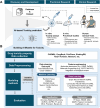Recent advances in AI-based toxicity prediction for drug discovery
- PMID: 40698059
- PMCID: PMC12279745
- DOI: 10.3389/fchem.2025.1632046
Recent advances in AI-based toxicity prediction for drug discovery
Abstract
Toxicity, defined as the potential harm a substance can cause to living organisms, requires the implementation of stringent regulatory standards to ensure public safety. These standards involve comprehensive testing frameworks, including hazard identification, dose-response evaluation, exposure assessment, and risk characterization. In drug discovery and development, these processes are often complex, time-consuming, and also resource-intensive. Toxicity-related failures in the later stages of drug development can lead to substantial financial losses, underscoring the need for reliable toxicity prediction during the early discovery phases. The advent of computational approaches has accelerated a shift toward in silico modeling, virtual screening, and, notably, artificial intelligence (AI) to identify potential toxicities earlier in the pipeline. Ongoing advances in databases, algorithms, and computational power have further expanded AI's role in pharmaceutical research. Today, AI models are capable of predicting wide range of toxicity endpoints, such as hepatotoxicity, cardiotoxicity, nephrotoxicity, neurotoxicity, and genotoxicity, based on diverse molecular representations ranging from traditional descriptors to graph-based methods. This review provides an in-depth examination of AI-driven toxicity prediction, emphasizing its transformative impact on drug discovery and its growing importance in improving safety assessments.
Keywords: artificial intelligence; drug discovery; in silico methods; toxicity; virtual screening.
Copyright © 2025 Lee, Kim, Kim and Lee.
Conflict of interest statement
The authors declare that the research was conducted in the absence of any commercial or financial relationships that could be construed as a potential conflict of interest.
Figures


Similar articles
-
AI-Driven Antimicrobial Peptide Discovery: Mining and Generation.Acc Chem Res. 2025 Jun 17;58(12):1831-1846. doi: 10.1021/acs.accounts.0c00594. Epub 2025 Jun 3. Acc Chem Res. 2025. PMID: 40459283 Free PMC article. Review.
-
The Potential of Artificial Intelligence in Pharmaceutical Innovation: From Drug Discovery to Clinical Trials.Pharmaceuticals (Basel). 2025 May 25;18(6):788. doi: 10.3390/ph18060788. Pharmaceuticals (Basel). 2025. PMID: 40573185 Free PMC article. Review.
-
Identifying and Addressing Bullying.2023 Dec 13. In: StatPearls [Internet]. Treasure Island (FL): StatPearls Publishing; 2025 Jan–. 2023 Dec 13. In: StatPearls [Internet]. Treasure Island (FL): StatPearls Publishing; 2025 Jan–. PMID: 28722959 Free Books & Documents.
-
The impact of artificial intelligence on the endoscopic assessment of inflammatory bowel disease-related neoplasia.Therap Adv Gastroenterol. 2025 Jun 23;18:17562848251348574. doi: 10.1177/17562848251348574. eCollection 2025. Therap Adv Gastroenterol. 2025. PMID: 40556746 Free PMC article. Review.
-
Short-Term Memory Impairment.2024 Jun 8. In: StatPearls [Internet]. Treasure Island (FL): StatPearls Publishing; 2025 Jan–. 2024 Jun 8. In: StatPearls [Internet]. Treasure Island (FL): StatPearls Publishing; 2025 Jan–. PMID: 31424720 Free Books & Documents.
References
-
- Alves V. M., Muratov E., Fourches D., Strickland J., Kleinstreuer N., Andrade C. H., et al. (2015). Predicting chemically-induced skin reactions. Part I: QSAR models of skin sensitization and their application to identify potentially hazardous compounds. Toxicol. Appl. Pharmacol. 284 (2), 262–272. 10.1016/j.taap.2014.12.014 - DOI - PMC - PubMed
-
- An FDA Artificial Intelligence (AI) (2024). Program for toxicology. Available online at: https://www.fda.gov/about-fda/nctr-research-focus-areas/artificial-intel... (Accessed June 13, 2025).
Publication types
LinkOut - more resources
Full Text Sources

